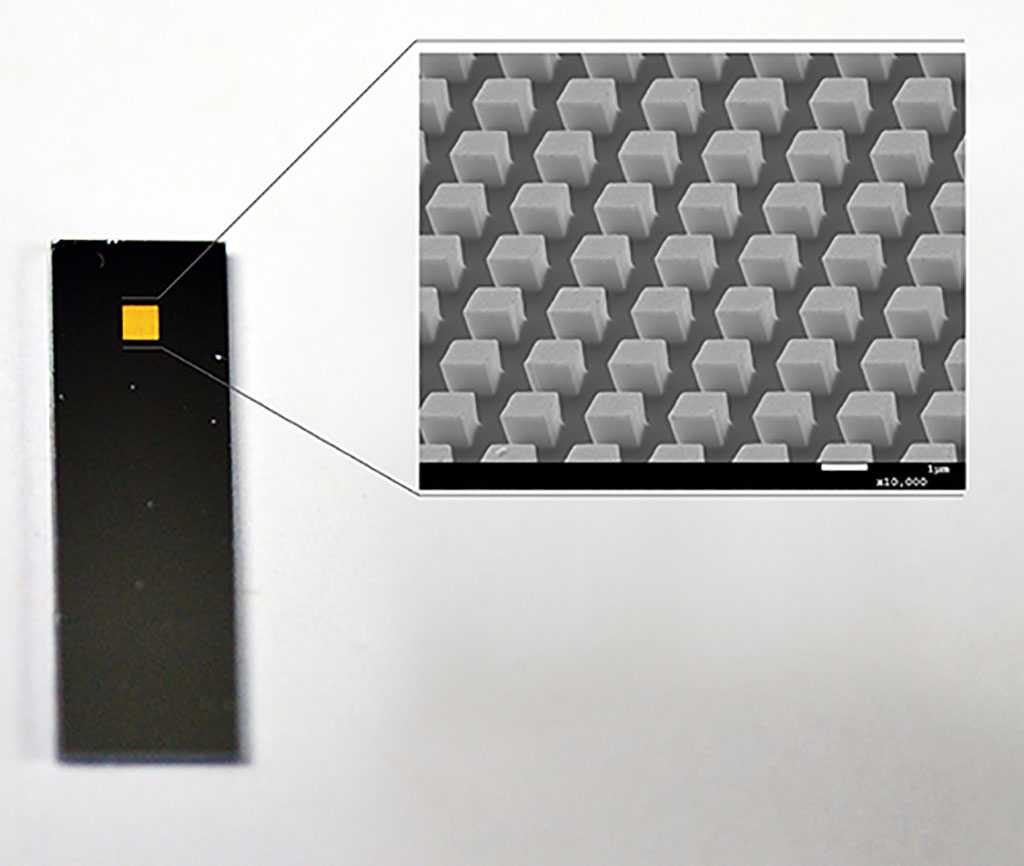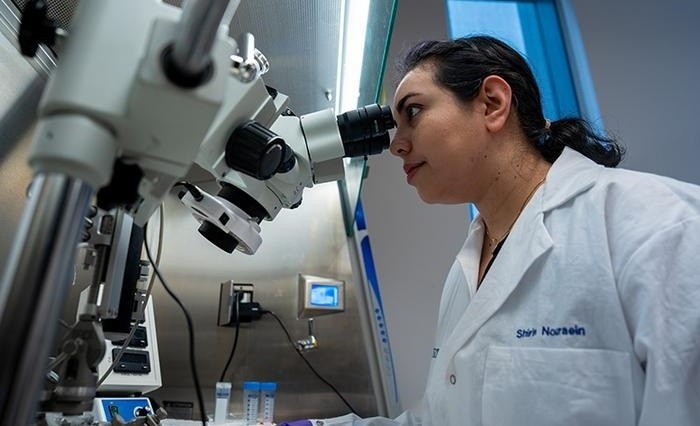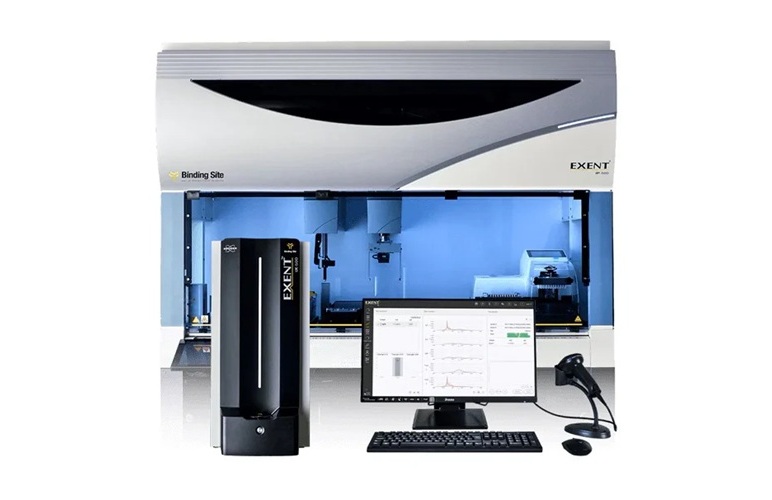New Diagnostic Device Identifies COVID-19 Patients at Risk of Potentially Lethal Cytokine Storm
|
By LabMedica International staff writers Posted on 19 Feb 2021 |

Image: The Immuno-storm chip is about the size of a 20c coin (Photo courtesy of AIBN)
Researchers have developed a diagnostic device, called an Immuno-storm chip, that could identify which cancer and COVID-19 patients are at risk of a potentially lethal ‘cytokine storm’.
The device was invented by scientists from the Australian Institute for Bioengineering and Nanotechnology (AIBN) at The University of Queensland (Queensland, Australia) and could help healthcare workers triage and closely monitor high risk patients and to begin treatment much earlier.
Cytokines are small proteins that act as messengers between cells in the immune system. They play a critical role in triggering inflammation by stimulating the movement of immune cells toward sites of injury or infection. However, if the release of cytokines becomes uncontrolled, this causes hyperinflammation which damages tissue. This, in turn, causes more cytokines to be released in a vicious, potentially lethal cycle called a ‘cytokine storm’. Cytokine storms can arise during a variety of diseases, as well as in response to immune-therapies. Unfortunately, it’s very difficult to predict who will develop a cytokine storm. Until recently, they were thought to arise very suddenly, but there is now evidence that a very faint but distinctive pattern of cytokines begins to emerge several days before the full-blown storm.
Scientists at the AIBN have developed a nanotechnology device, called an Immuno-storm chip, that can detect this early warning signal on a miniaturized platform with minimal sample. They designed a nanoscale array of gold pillars to which they attached antibodies that stick to specific cytokines in blood. If these cytokines are present in a blood sample as small as a single drop, they will bind to the gold ‘nanopillars’. These captured cytokines are then detected by gold-silver ‘nanotag’ particles. The team designed these nanotags to emit light whenever they encounter a cytokine. The chip’s small size - about the size of a SIM card - meant the diagnostic technology could eventually be made relatively portable.
“Whether in a cancer treatment setting or when monitoring infectious diseases such as acute COVID-19, long-haul COVID-19 and sepsis, the Immuno-storm chip could provide critical medical information that guides important clinical decisions. Critically, it could inform doctors to begin, or to ease off treatments, by accurately monitoring the patient’s immune response before it goes crazy,” said Professor Matt Trau, a researcher AIBN. “Detection of the detailed cytokine signature for vulnerable COVID-19 patients with the Immuno-storm chip could also be used to personalize the therapy of these patients, tuned in to alleviate their specific excessive immune system response.”
Related Links:
The University of Queensland
The device was invented by scientists from the Australian Institute for Bioengineering and Nanotechnology (AIBN) at The University of Queensland (Queensland, Australia) and could help healthcare workers triage and closely monitor high risk patients and to begin treatment much earlier.
Cytokines are small proteins that act as messengers between cells in the immune system. They play a critical role in triggering inflammation by stimulating the movement of immune cells toward sites of injury or infection. However, if the release of cytokines becomes uncontrolled, this causes hyperinflammation which damages tissue. This, in turn, causes more cytokines to be released in a vicious, potentially lethal cycle called a ‘cytokine storm’. Cytokine storms can arise during a variety of diseases, as well as in response to immune-therapies. Unfortunately, it’s very difficult to predict who will develop a cytokine storm. Until recently, they were thought to arise very suddenly, but there is now evidence that a very faint but distinctive pattern of cytokines begins to emerge several days before the full-blown storm.
Scientists at the AIBN have developed a nanotechnology device, called an Immuno-storm chip, that can detect this early warning signal on a miniaturized platform with minimal sample. They designed a nanoscale array of gold pillars to which they attached antibodies that stick to specific cytokines in blood. If these cytokines are present in a blood sample as small as a single drop, they will bind to the gold ‘nanopillars’. These captured cytokines are then detected by gold-silver ‘nanotag’ particles. The team designed these nanotags to emit light whenever they encounter a cytokine. The chip’s small size - about the size of a SIM card - meant the diagnostic technology could eventually be made relatively portable.
“Whether in a cancer treatment setting or when monitoring infectious diseases such as acute COVID-19, long-haul COVID-19 and sepsis, the Immuno-storm chip could provide critical medical information that guides important clinical decisions. Critically, it could inform doctors to begin, or to ease off treatments, by accurately monitoring the patient’s immune response before it goes crazy,” said Professor Matt Trau, a researcher AIBN. “Detection of the detailed cytokine signature for vulnerable COVID-19 patients with the Immuno-storm chip could also be used to personalize the therapy of these patients, tuned in to alleviate their specific excessive immune system response.”
Related Links:
The University of Queensland
Latest COVID-19 News
- New Immunosensor Paves Way to Rapid POC Testing for COVID-19 and Emerging Infectious Diseases
- Long COVID Etiologies Found in Acute Infection Blood Samples
- Novel Device Detects COVID-19 Antibodies in Five Minutes
- CRISPR-Powered COVID-19 Test Detects SARS-CoV-2 in 30 Minutes Using Gene Scissors
- Gut Microbiome Dysbiosis Linked to COVID-19
- Novel SARS CoV-2 Rapid Antigen Test Validated for Diagnostic Accuracy
- New COVID + Flu + R.S.V. Test to Help Prepare for `Tripledemic`
- AI Takes Guesswork Out Of Lateral Flow Testing
- Fastest Ever SARS-CoV-2 Antigen Test Designed for Non-Invasive COVID-19 Testing in Any Setting
- Rapid Antigen Tests Detect Omicron, Delta SARS-CoV-2 Variants
- Health Care Professionals Showed Increased Interest in POC Technologies During Pandemic, Finds Study
- Set Up Reserve Lab Capacity Now for Faster Response to Next Pandemic, Say Researchers
- Blood Test Performed During Initial Infection Predicts Long COVID Risk
- Low-Cost COVID-19 Testing Platform Combines Sensitivity of PCR and Speed of Antigen Tests
- Finger-Prick Blood Test Identifies Immunity to COVID-19
- Quick Test Kit Determines Immunity Against COVID-19 and Its Variants
Channels
Clinical Chemistry
view channel
Chemical Imaging Probe Could Track and Treat Prostate Cancer
Prostate cancer remains a leading cause of illness and death among men, with many patients eventually developing resistance to standard hormone-blocking therapies. These drugs often lose effectiveness... Read more
Mismatch Between Two Common Kidney Function Tests Indicates Serious Health Problems
Creatinine has long been the standard for measuring kidney filtration, while cystatin C — a protein produced by all human cells — has been recommended as a complementary marker because it is influenced... Read moreMolecular Diagnostics
view channel
New Serum Marker-Editing Strategy to Improve Diagnosis of Neurological Diseases
Tracking gene-expression changes in the brain is crucial for understanding neurological diseases, yet current monitoring tools are invasive or unable to capture subtle activity shifts over time.... Read more
World’s First Genetic Type 1 Diabetes Risk Test Enables Early Detection
Type 1 Diabetes (T1D) affects more than eight million people worldwide, with numbers expected to rise sharply. While most cases are genetically driven, only one in ten patients has a family history, making... Read moreHematology
view channel
Platelet Activity Blood Test in Middle Age Could Identify Early Alzheimer’s Risk
Early detection of Alzheimer’s disease remains one of the biggest unmet needs in neurology, particularly because the biological changes underlying the disorder begin decades before memory symptoms appear.... Read more
Microvesicles Measurement Could Detect Vascular Injury in Sickle Cell Disease Patients
Assessing disease severity in sickle cell disease (SCD) remains challenging, especially when trying to predict hemolysis, vascular injury, and risk of complications such as vaso-occlusive crises.... Read more
ADLM’s New Coagulation Testing Guidance to Improve Care for Patients on Blood Thinners
Direct oral anticoagulants (DOACs) are one of the most common types of blood thinners. Patients take them to prevent a host of complications that could arise from blood clotting, including stroke, deep... Read moreImmunology
view channel
Gene Signature Test Predicts Response to Key Breast Cancer Treatment
DK4/6 inhibitors paired with hormone therapy have become a cornerstone treatment for advanced HR+/HER2– breast cancer, slowing tumor growth by blocking key proteins that drive cell division.... Read more
Chip Captures Cancer Cells from Blood to Help Select Right Breast Cancer Treatment
Ductal carcinoma in situ (DCIS) accounts for about a quarter of all breast cancer cases and generally carries a good prognosis. This non-invasive form of the disease may or may not become life-threatening.... Read moreMicrobiology
view channelRapid POC Tuberculosis Test Provides Results Within 15 Minutes
Tuberculosis remains one of the world’s deadliest infectious diseases, and reducing new cases depends on identifying individuals with latent infection before it progresses. Current diagnostic tools often... Read more
Rapid Assay Identifies Bloodstream Infection Pathogens Directly from Patient Samples
Bloodstream infections in sepsis progress quickly and demand rapid, precise diagnosis. Current blood-culture methods often take one to five days to identify the pathogen, leaving clinicians to treat blindly... Read morePathology
view channelAI Tool Outperforms Doctors in Spotting Blood Cell Abnormalities
Diagnosing blood disorders depends on recognizing subtle abnormalities in cell size, shape, and structure, yet this process is slow, subjective, and requires years of expert training. Even specialists... Read more
AI Tool Rapidly Analyzes Complex Cancer Images for Personalized Treatment
Complex digital biopsy images that typically take an expert pathologist up to 20 minutes to assess can now be analyzed in about one minute using a new artificial intelligence (AI) tool. The technology... Read moreTechnology
view channel
AI Saliva Sensor Enables Early Detection of Head and Neck Cancer
Early detection of head and neck cancer remains difficult because the disease produces few or no symptoms in its earliest stages, and lesions often lie deep within the head or neck, where biopsy or endoscopy... Read more
AI-Powered Biosensor Technology to Enable Breath Test for Lung Cancer Detection
Detecting lung cancer early remains one of the biggest challenges in oncology, largely because current tools are invasive, expensive, or unable to identify the disease in its earliest phases.... Read moreIndustry
view channel
Abbott Acquires Cancer-Screening Company Exact Sciences
Abbott (Abbott Park, IL, USA) has entered into a definitive agreement to acquire Exact Sciences (Madison, WI, USA), enabling it to enter and lead in fast-growing cancer diagnostics segments.... Read more



























